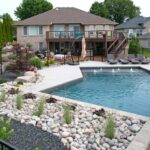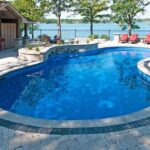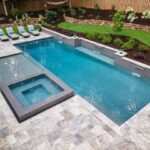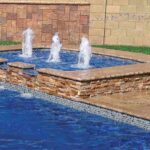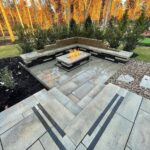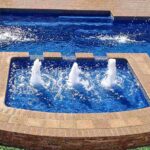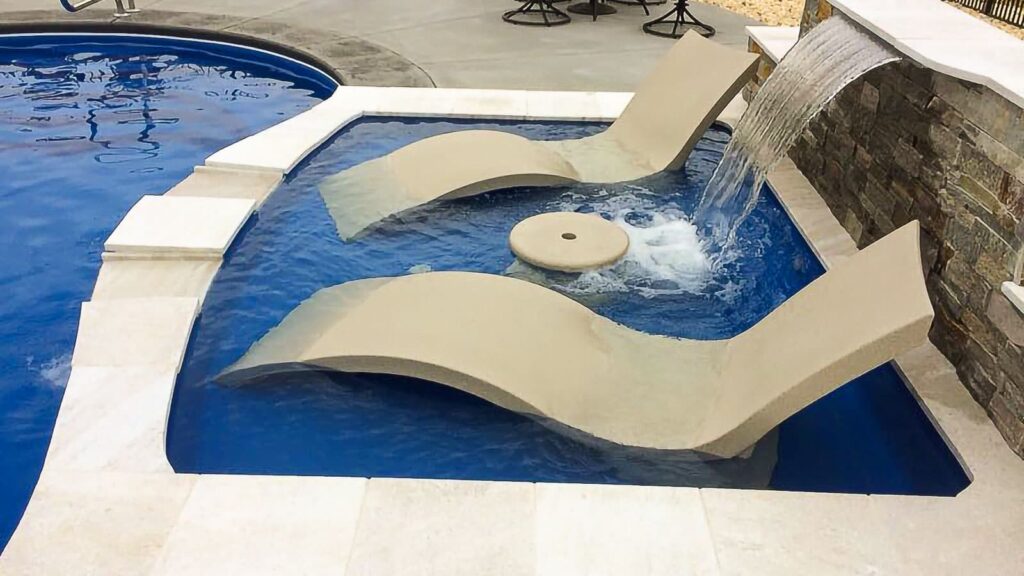
Comparison Between Concrete Pools and Fiberglass Pools.
Fiberglass Pools and Concrete Pools are quite popular choices for a long-term pool.
Fiberglass pools can cost up to $45,000 and require little maintenance. They are pre-built on existing molds and can be up and running in 3–6 weeks.
Concrete pools can cost $50,000 or more and require costly long-term maintenance. They’re highly customizable, but installation takes 3–6 months.
We want you to be well informed to make the best decision for you and your family.
- Cost Production Comparison
Concrete Pools.
The initial cost of constructing a concrete pool is typically between $50,000 and $100,000.
Concrete pools require a lot of TLC to stay in good shape, so budget for long-term maintenance such as acid washing, refinishing, and energy usage. Because of the extensive upkeep, a concrete pool’s maintenance costs more than $25,000 every ten years.
Fiberglass Pools.
Most fiberglass pool projects cost between $45,000 and $85,000 for manufacturing and installation. Still, depending on your chosen landscaping, accessories, and water features, they can cost much more.
Though we do not recommend DIY-ing a fiberglass pool, some people do choose to install their pool, which can cost between $12,000 and $30,000, depending on the pool size and any upgrades.
Long-term, your only significant maintenance costs will be chemicals and electricity. Spending nearly $4000 over ten years is a possibility.
Findings
Both have roughly the same upfront costs, but Concrete Pools are far more expensive in the long run. So this comparison shows that the Fiberglass Pools come up on top.
- Time for Installation
Concrete Pools
A Concrete Pool takes 3–6 months to build and is typically done using the Gunite process. That is a long time to want to cry every time you look at your wrecked backyard.
Fiberglass Pools
The fiberglass pool shell is manufactured off-site. After we deliver the pool to your backyard, it will be installed and ready for swimming in about two days. It will take another week or two to complete the patio and decking. From start to finish, the process usually takes 3–5 weeks.
Findings
Only the installation portion of the Fiberglass Pool process is visible, not the messy manufacturing. Installation takes weeks rather than months.
- Surface texture on the inside
Concrete Pools
The roughest interior surface for concrete is plaster, which scrapes your skin badly.
Exposed aggregate (such as pebbles) isn’t as rough, but the hard bumps can be painful to walk on. Polished aggregate can help with this.
The smoothest finish is tile, but it is also the most expensive.
Fiberglass Pools
The gel coat refers to the interior surface of a fiberglass pool. It feels nice to the touch. Steps and tanning ledges are designed with an anti-slip texture, but even this is not rough.
Findings
Smoothing out the surface of a concrete pool costs an arm and a leg. By definition, a Fiberglass Pool is smooth and pain-free.
- Durable
Concrete Pools
A concrete pool’s structure—that is, the solid concrete—is extremely long-lasting.
All interior finishes for concrete pools, including basic plaster, are durable enough to withstand damage to toys, dogs, or tree branches. It would help if you plastered the pool every 10–15 years, including replacing the waterline tile.
If you salt-chlorine chlorine generator, the dissolved salt in the water will shorten the life of a plaster-based interior finish even more (which includes aggregate). Saltwater water does not affect the finish of a tile.
Fiberglass Pools
Both the gel coat finish and the pool structure are extremely long-lasting.
A salt chlorine generator can also be used for low maintenance and silkier water, as the salt has no negative effects on the fiberglass shell.
Findings
Although both surfaces are strong and long-lasting, concrete pools are susceptible to salt and must be refinished. In this case, Fiberglass Pools come out on top.
- On-the-job maintenance
Concrete Pools
Concrete’s alkalinity raises the pH of the water, necessitating the daily application of muriatic acid (hydrochloric acid).
To remove any surface algae, clean the entire surface of the pool with a steel brush at least once a week.
Fiberglass Pools
The gel coat also does not affect the pH of the water, so it is rarely necessary to add acid to balance it. However, you must continue to test the chemistry of your water weekly.
Findings
Concrete pools should have an inspection weekly, whereas Fiberglass Pools do not. Fiberglass Pools have an edge in this one too.
- Algae
Concrete Pools
Algae thrive in Concrete Pools with many pores and cavities. Brushing the pool at least once a week is a recommendation.
Fiberglass Pools
A fiberglass pool’s gel coat is smooth and algae-resistant, with only microscopic pores preventing algae from burrowing into it.
Findings
Regardless of pool type, regular maintenance can keep your lovely pool from turning into a pond. A Fiberglass Pool, on the other hand, makes this much easier.
- Chemicals and electricity
Concrete Pools
You must set aside time and money to purchase and apply additional chemicals to kill algae. Aside from that, because concrete is alkaline, you must add acid regularly to keep the water chemistry balanced.
Fiberglass Pools
Fiberglass pools require less electricity and fewer chemicals to stay in good condition. Less money, time, and effort are of the essence. Nice!
Findings
The high maintenance requirements of concrete translate to higher chemical and electricity consumption.
You are the only one who knows the priorities of your pool. Consider these various characteristics when determining the best fit for you and your family.
Perhaps the pool must meet your specific aesthetic requirements regardless of cost. Perhaps you’d rather save money than have your product customized.
PoolForce is the place to start when looking for a Fiberglass, Gunite, or Vinyl liner pool. Contact our team, and we will assist you in determining which options are best for your preferences, budget, and lifestyle.
Which is your favorite pool? Tell us in the comment section.
We eagerly await your response.
Check out our other blogs as well; we have a lot to offer in pool knowledge.



